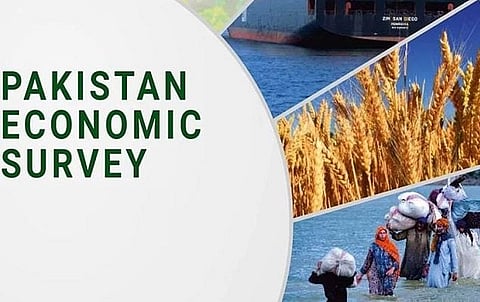

Pakistan achieved a gross domestic product (GDP) growth of 2.38 percent, surpassing the target of 2 percent, as Finance Minister Muhammad Aurangzeb revealed in the Economic Survey of Pakistan 2023-24, Islamabad on June 11. This survey was published ahead of the federal budget 2024-25, set to be presented today (June 12).
The survey detailed major socio-economic developments, sectoral performance, and economic trends across various sectors such as agriculture, manufacturing, services, energy, information technology, capital markets, health, education, and transport.
Notable Progress in Macro-Economic Stability:
Federal Finance Minister Senator Muhammad Aurangzeb highlighted that despite challenges, Pakistan made notable progress towards macroeconomic stability. This includes a remarkable 30 percent increase in revenue collection, a reduced current account deficit, lower inflation, and a stable currency. This marks a significant recovery from a previous economic downturn characterized by a 0.2 percent GDP contraction, 29 percent rupee depreciation, and dwindling foreign exchange reserves.
Aurangzeb acknowledged that despite issues in the large-scale manufacturing (LSM) sector due to high interest rates and energy challenges, the agriculture sector’s bumper crops played a key role in the country’s GDP growth.
Agriculture & Dairy to Drive Future Growth:
The survey indicated that the investment-to-GDP ratio fell to 13.14 percent in FY2024 from 14.13 percent in FY2023, primarily due to macroeconomic policies and political uncertainty. However, real GDP grew by 2.38 percent in FY2024, aided by prudent policy management, resumed inflows from international partners, and economic recovery among key trading partners.
Notably, the agriculture sector experienced its highest growth in 19 years, becoming a significant driver of economic progress in FY2024. Inflation has been steadily declining since the third quarter of FY2024.
The agriculture sector saw robust growth of 6.25 percent in FY2024. Key crop production is increased by 16.82 percent, including significant rises in cotton (108.2%), rice (34.8%), and wheat (11.6%). However, sugarcane and maize production declined by 0.4 percent and 10.4 percent, respectively, partly due to crop switching. Other crops showed a 0.90 percent growth, reversing a previous contraction, with notable increases in fruits (8.40%), vegetables (5.77%), and pulses (1.45%). Cotton ginning grew by 47.23 percent due to high cotton production.
Interest Payments are becomes Burden:
Revenue consolidation measures boosted income, though expenditures remained high due to increased interest payments. The fiscal deficit stood at 3.7 percent of GDP during July-March FY2024, unchanged from the previous year. Improved revenue mobilization and controlled non-interest spending enhanced the primary surplus to Rs.1615.4 billion (1.5% of GDP) from Rs.503.8 billion (0.6% of GDP) last year. Total expenditure increased by 36.6 percent, with current expenditures rising by 33.4 percent. Development expenditures grew by 14.2 percent, though the Federal PSDP saw a slight decline. Total revenues increased by 41 percent, with non-tax collection rising by 90.7 percent and tax collection by 29.3 percent. The Federal Board of Revenue (FBR) reported a 30.8 percent increase in net tax collection during July-May FY2024.
All four provinces posted a combined surplus of Rs.435.5 billion during July-March FY2024, slightly lower than the Rs.456.0 billion last year. The government aims to strengthen public finances through various reforms to reduce borrowing dependence, mitigate debt risks, and create room for social assistance and development spending.
The survey noted a deceleration in global growth due to slowdowns in advanced economies, driven by contractionary monetary policies aimed at controlling inflation. Global economic growth slowed from 3.5 percent in 2022 to 3.2 percent in 2023 and is projected to maintain this pace through 2024 and 2025.
